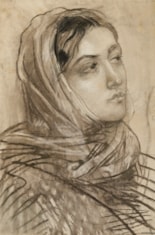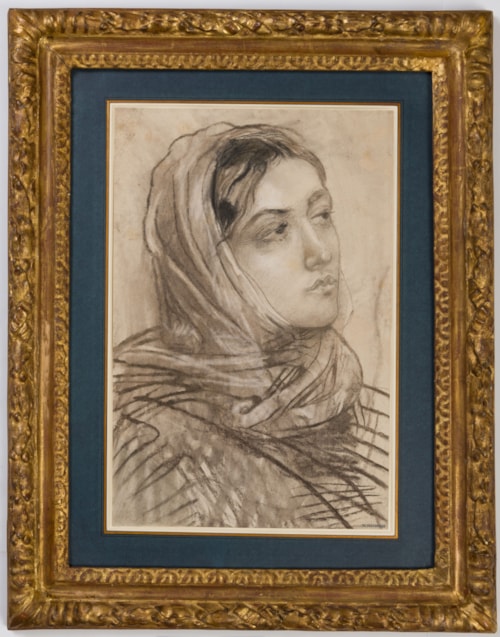Théodore CHASSERIAU
(El Limón (Santo Domingo) 1819 - Paris 1856)
Portrait of a Woman in a Head Scarf
Charcoal and white chalk on laid paper.
A made-up section at the lower left.
Stamped with the posthumous Chassériau atelier sale stamp (Lugt 443) at the lower right.
447 x 295 mm. (17 5/8 x 11 5/8 in.)
A made-up section at the lower left.
Stamped with the posthumous Chassériau atelier sale stamp (Lugt 443) at the lower right.
447 x 295 mm. (17 5/8 x 11 5/8 in.)
This powerful late drawing is a preparatory study for the head of the woman kneeling behind the Virgin in Théodore Chassériau’s The Descent from the Cross, painted between 1852 and 1855 in the apse of the Parisian church of Saint-Philippe-du-Roule. Commissioned from Chassériau in February 1852 by the Ministry of the Interior, The Descent from the Cross was planned as a large mural hemicycle composition. A finished maquette for the work is in Musée des Beaux-Arts de la Ville de Paris at the Petit Palais in Paris, while an early preparatory oil sketch for the composition is in the Musée d’Orsay in Paris. Several preparatory drawings by Chassériau for other figures in this monumental hemicycle composition are known. The present sheet may also have served as a study for the head of the Virgin in Chasseriau’s easel picture of The Adoration of the Magi, signed and dated 1856, which is today also in the collection of the Petit Palais.
The present sheet is known in two autograph versions, although the other drawn version of this head is less finished and shows much less of the sitter’s clothing. As Louis-Antoine Prat has noted, it is rare to find two drawings by Chassériau of the same subject or sitter, and only six or seven examples are known, including portrait drawings of the artist’s brother Ernest and his favourite model Marie Cantacuzène.
As the 19th century writer and art critic Théophile Gautier noted of the women in the artist’s paintings, ‘The only modern aspect of Chassériau’s heads are the eyes, imbued with a dreamy fixity or drowned in a nostalgic languor…these figures, with their dull serenity and disdainful passivity, are reminiscent of the beautiful Greek slaves captive at the court of some barbarian king…’ While the model for the present sheet was previously identified as one of Chassériau’s two sisters Adèle or Aline, it is more likely to have been his close friend and muse, Marie Cantacuzène (1820-1898), a Romanian princess whom the artist first met around 1854 or 1855, when he lived near her on the Avenue Frochot in Paris. Born Maria Cantacuzino in 1820 in Horodnitzeni in Moldavia, she had arrived in Paris in 1850, and was estranged from her second husband, Prince Alexander Kantakuzen (from the Russian branch of her family), whom she had married in 1839. Gallicizing her name, she settled happily in Paris, despite the strong disapproval of her family in Romania.
Princess Marie Cantacuzène was to model for a number of Chassériau’s paintings. The artist’s great biographer, Léonce Bénédite, noted that ‘the feeling which Chassériau might have had for Princess Cantacuzène had no resemblance to those which he had for other women…The princess is not a beautiful woman, but she has a very interesting physiognomy with her heavy hair arranged in bandeaux nodules, her lovely sweet and serious eyes, her small fresh and lovely mouth, her elongated and thin face, her pensive air, the distinction of her whole figure and her slightly melancholic grace. What Chassériau found in her… and what explains his true adoration, is a soul.’ It was through Chassériau that, in 1856, Marie Cantacuzène met the painter Pierre Puvis de Chavannes. The two were to become lifetime companions, eventually marrying in 1897, when both were in their seventies. As she had with Chassériau, Marie Cantacuzène posed often for figures in paintings by Puvis de Chavannes.
The present sheet is known in two autograph versions, although the other drawn version of this head is less finished and shows much less of the sitter’s clothing. As Louis-Antoine Prat has noted, it is rare to find two drawings by Chassériau of the same subject or sitter, and only six or seven examples are known, including portrait drawings of the artist’s brother Ernest and his favourite model Marie Cantacuzène.
As the 19th century writer and art critic Théophile Gautier noted of the women in the artist’s paintings, ‘The only modern aspect of Chassériau’s heads are the eyes, imbued with a dreamy fixity or drowned in a nostalgic languor…these figures, with their dull serenity and disdainful passivity, are reminiscent of the beautiful Greek slaves captive at the court of some barbarian king…’ While the model for the present sheet was previously identified as one of Chassériau’s two sisters Adèle or Aline, it is more likely to have been his close friend and muse, Marie Cantacuzène (1820-1898), a Romanian princess whom the artist first met around 1854 or 1855, when he lived near her on the Avenue Frochot in Paris. Born Maria Cantacuzino in 1820 in Horodnitzeni in Moldavia, she had arrived in Paris in 1850, and was estranged from her second husband, Prince Alexander Kantakuzen (from the Russian branch of her family), whom she had married in 1839. Gallicizing her name, she settled happily in Paris, despite the strong disapproval of her family in Romania.
Princess Marie Cantacuzène was to model for a number of Chassériau’s paintings. The artist’s great biographer, Léonce Bénédite, noted that ‘the feeling which Chassériau might have had for Princess Cantacuzène had no resemblance to those which he had for other women…The princess is not a beautiful woman, but she has a very interesting physiognomy with her heavy hair arranged in bandeaux nodules, her lovely sweet and serious eyes, her small fresh and lovely mouth, her elongated and thin face, her pensive air, the distinction of her whole figure and her slightly melancholic grace. What Chassériau found in her… and what explains his true adoration, is a soul.’ It was through Chassériau that, in 1856, Marie Cantacuzène met the painter Pierre Puvis de Chavannes. The two were to become lifetime companions, eventually marrying in 1897, when both were in their seventies. As she had with Chassériau, Marie Cantacuzène posed often for figures in paintings by Puvis de Chavannes.
Although he died at the age of only thirty-six, Théodore Chassériau enjoyed a successful and somewhat controversial career. Born in the Caribbean to a French father and Creole mother in Santo Domingo (now the Dominican Republic), he moved with his family to Paris in 1822, at the age of three, and was raised largely by his eldest brother Frédéric. At the age of eleven or twelve he was admitted as a pupil into the studio of Jean-Auguste-Dominique Ingres, a period of instruction that ended in 1834 when Ingres left for Rome to become director of the Académie de France. Two years later, in 1836, Chassériau made his debut at the Salon, exhibiting two paintings which won him a third-class medal. He continued to exhibit regularly at the annual Salons, although his paintings were not always accepted by the juries. Portraits and religious subjects made up much of his output, the latter including a number of major decorative commissions for churches in Paris and elsewhere.
The single most significant public commission of Chassériau’s career, however, was secular in nature; the mural decoration of the staircase of the Cour de Comptes in the old Palais d’Orsay in Paris, begun in 1844 and completed in 1848. Painted entirely without the aid of assistants, the fifteen large panels that made up the decoration amounted to the most substantial mural project undertaken by a French artist up to that time and earned Chassériau the sum of thirty thousand francs. Greatly admired by all who saw them, almost the entire decorative scheme of the Cour de Comptes was largely destroyed by a fire during the Commune of 1871, and only fragments survive today. Later public commissions included the decoration of the apse of the church of Saint-Philippe-du-Roule, completed in 1855, and the baptismal chapel of Saint Roch.
Chassériau was a gifted and prolific draughtsman, producing numerous preparatory studies for each of his works as well as finished portrait drawings. Apart from a group of 152 drawings sold at auction in Paris in 1857, the bulk of the drawings from Chassériau’s studio, numbering over 2,200 individual sheets and thirty-seven sketchbooks, were retained in the family of the artist for over seventy years, before being presented to the Louvre in 1934.
The single most significant public commission of Chassériau’s career, however, was secular in nature; the mural decoration of the staircase of the Cour de Comptes in the old Palais d’Orsay in Paris, begun in 1844 and completed in 1848. Painted entirely without the aid of assistants, the fifteen large panels that made up the decoration amounted to the most substantial mural project undertaken by a French artist up to that time and earned Chassériau the sum of thirty thousand francs. Greatly admired by all who saw them, almost the entire decorative scheme of the Cour de Comptes was largely destroyed by a fire during the Commune of 1871, and only fragments survive today. Later public commissions included the decoration of the apse of the church of Saint-Philippe-du-Roule, completed in 1855, and the baptismal chapel of Saint Roch.
Chassériau was a gifted and prolific draughtsman, producing numerous preparatory studies for each of his works as well as finished portrait drawings. Apart from a group of 152 drawings sold at auction in Paris in 1857, the bulk of the drawings from Chassériau’s studio, numbering over 2,200 individual sheets and thirty-seven sketchbooks, were retained in the family of the artist for over seventy years, before being presented to the Louvre in 1934.
Provenance
Probably the Chassériau atelier sale, Paris, Hôtel Drouot, 16-17 March 1857
Shepherd Gallery, New York, by 1984
Anonymous sale, Paris, Hôtel Drouot, 27 November 1987, lot 2 (as a portrait of the artist’s sister)
Galerie Schmit, Paris, in 1988
Robert and Nadine Schmit, Paris
Thence by descent.
Shepherd Gallery, New York, by 1984
Anonymous sale, Paris, Hôtel Drouot, 27 November 1987, lot 2 (as a portrait of the artist’s sister)
Galerie Schmit, Paris, in 1988
Robert and Nadine Schmit, Paris
Thence by descent.
Literature
New York, Shepherd Gallery, Twenty Nineteenth Century Works of Art: Paintings, Drawings and Sculpture, exhibition catalogue, 1986, unpaginated, no.9 (as a portrait of the artist’s sister); Louis-Antoine Prat, Cahiers du dessin français. Théodore Chassériau 1819-1856: Dessins conservés en dehors du Louvre, Paris, 1988, p.27, no.203 (not illustrated).
Exhibition
New York, Shepherd Gallery, French Nineteenth Century Paintings, Drawings, Pastels and Watercolors, Spring 1984, no.40; New York, Shepherd Gallery, Twenty Nineteenth Century Works of Art: Paintings, Drawings and Sculpture, 1986, no.9; Paris, Galerie Schmit, Maîtres français: XIXe-XXe siècles, 1988, no.16 (titled Portrait de la sœur de l’artiste, and with provenance from the Cantacuzène family, Paris).





